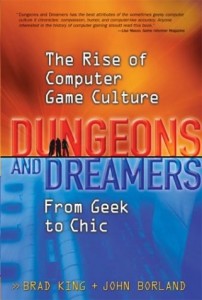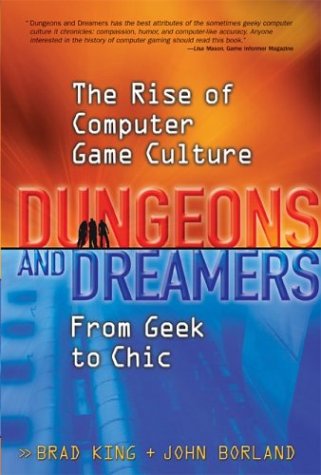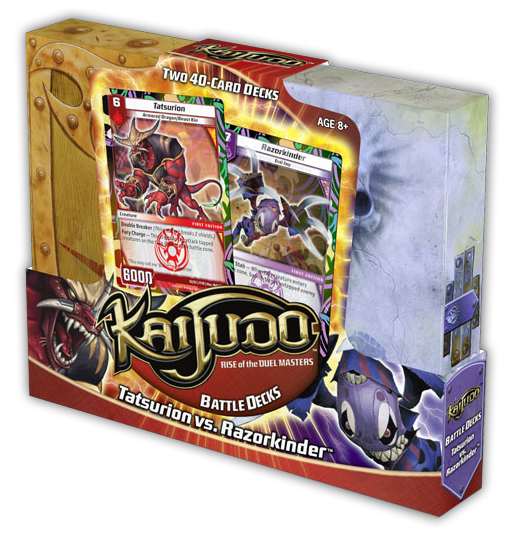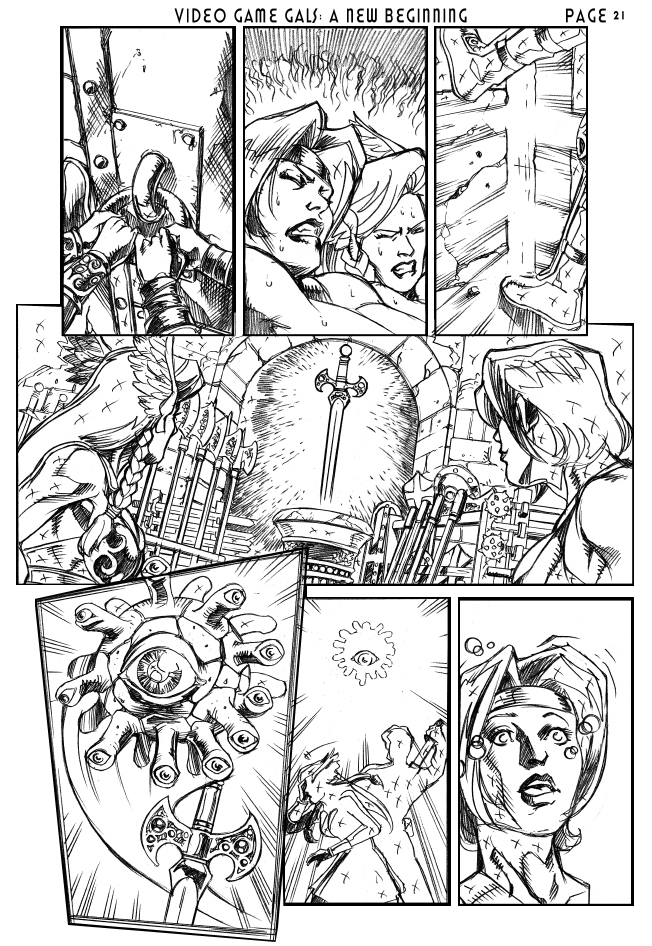Dungeons and Dreamers: The Rise of Computer Game Culture From Geek to Chic
 Written by Wired contributor Brad King and CNET’s John Borland, Dungeons and Dreamers: The Rise of Computer Game Culture From Geek to Chic traces the development of computer gaming from Dave Arneson’s and Gary Gygax’s tabletop Dungeons and Dragons up until 2003, when Dungeons and Dreamers was published. The majority of the book focuses on Ultima-creator Richard Garriot, followed by attention to John Romero and Eric Carmack of id software responsible for such hits as Wolfenstein 3D, DOOM, and Quake. When not focused on these three gaming gods, the authors take a look into the world of the orginal MUD (Multi User Dungeon) developed in Britain by Richard Bartle, foray into Will Wright’s Sims titles, explore LAN parties and the rise of professional gaming, and touch upon computer video game violence. Almost everything else is left out of the book. There is no Monkey Island, no reference to Sid Meier’s Civilization, nor mention of King’s Quest or X-Wing, much less Oregon Trail. Almost absent are any real time strategy titles like Warcraft I or II, Starcraft, Total Annihilation, and Command and Conquer. Everquest is mentioned multiple times, but its creators are absent from the authors’ narrative. Meanwhile World of Warcraft was still in development and released a year later. Missing too is any explanation of how computer game culture has actually gone from geek to chic, as well as a close look at what actually constitutes computer game culture. For example, there is nothing about l33t speak, energy drinks like Bawls, or Penny Arcade, to name three of the more visible aspects of computer game culture already in existence in 2003. To pick up where King and Borland leave off with Dungeons and Dreamers, I suggest Peter Ludlow’s and Mark Wallace’s Second Life Herald, which follows the story of Will Wright and his Sims Online and explores the rise of Second Life, as well as details griefing a bit more than Dungeons and Dreamers. However I actually read King’s and Borland’s book more to see what it has to say about tabletop gaming, but even there I found it slightly missing the mark.
Written by Wired contributor Brad King and CNET’s John Borland, Dungeons and Dreamers: The Rise of Computer Game Culture From Geek to Chic traces the development of computer gaming from Dave Arneson’s and Gary Gygax’s tabletop Dungeons and Dragons up until 2003, when Dungeons and Dreamers was published. The majority of the book focuses on Ultima-creator Richard Garriot, followed by attention to John Romero and Eric Carmack of id software responsible for such hits as Wolfenstein 3D, DOOM, and Quake. When not focused on these three gaming gods, the authors take a look into the world of the orginal MUD (Multi User Dungeon) developed in Britain by Richard Bartle, foray into Will Wright’s Sims titles, explore LAN parties and the rise of professional gaming, and touch upon computer video game violence. Almost everything else is left out of the book. There is no Monkey Island, no reference to Sid Meier’s Civilization, nor mention of King’s Quest or X-Wing, much less Oregon Trail. Almost absent are any real time strategy titles like Warcraft I or II, Starcraft, Total Annihilation, and Command and Conquer. Everquest is mentioned multiple times, but its creators are absent from the authors’ narrative. Meanwhile World of Warcraft was still in development and released a year later. Missing too is any explanation of how computer game culture has actually gone from geek to chic, as well as a close look at what actually constitutes computer game culture. For example, there is nothing about l33t speak, energy drinks like Bawls, or Penny Arcade, to name three of the more visible aspects of computer game culture already in existence in 2003. To pick up where King and Borland leave off with Dungeons and Dreamers, I suggest Peter Ludlow’s and Mark Wallace’s Second Life Herald, which follows the story of Will Wright and his Sims Online and explores the rise of Second Life, as well as details griefing a bit more than Dungeons and Dreamers. However I actually read King’s and Borland’s book more to see what it has to say about tabletop gaming, but even there I found it slightly missing the mark.
Namely, to Brad King and John Borland, Dungeons and Dragons is a “paper game”. I have never heard of an RPG referred to as a “paper game” in over 20 years of playing. I would actually think someone was referring to the Paper Mario game possibly, but knowing what they were writing about, I could easily stretch it out to a pen and paper game, which I’ve certainly heard of before. Otherwise the authors are fairly succinct. D&D was hugely influential to almost all early computer game programmers and the authors begin the book with the fateful second meeting of Dave Arneson and Gary Gygax at Gygax’s house in Lake Geneva, Wisconsin in 1972 and the first heady game of what would become Dungeons & Dragons. As Dave Arneson describes the origins of D&D, “We were having a tremendous amount of fun, but we figured we were crazy, we had no inkling that this would turn out to be something so big.” King and Borland go on to substantiate the influence of D&D on programmers and just how influential the game was.
From King and Borland we learn that among Dungeons & Dragon’s earlier players was Richard Garriott who first played D&D at Oklahoma University at a computer programming summer camp in 1977. The son of NASA astronaut Owen Garriott, he would go on to write the Ultima series of games. I literally got goosebumps when the authors described his first meeting with his fellow summer campers, when one of them says “You must be from Britain, so we’ll call you British.” If you’ve never played an Ultima game, Lord British is the head of the realm and plays a huge role in the series. He pretty much is Ultima and is only surpassed in importance in the series by the player-controlled Avatar and frequent companion Iolo. King and Borland reveal that Garriott also developed his Lord British persona in Society for Creative Anachronism events in Austin, a passion which he shared with another gamer turned SCAdian named Steve Jackson. While Jackson went on to create and publish OGRE, Illuminati, Car Wars, and GURPS with his namesake Steve Jackson Games, he never got into video gaming because as Jackson is quoted as saying in the book, “I have always been very interested in the computer game world, but through bad decisions, bad luck, or both, I never got very far into it.”
The D&D players who did get into computer games included Willie Crowther with his Colossal Cave, Richard Bartle who developed the original MUD, and some of the creators of Zork with King and Borland tracing the lineage of these text-based games over the internet-forerunner ARPAnet in the 1970s. In terms of first person shooters, King and Borland tap gaming superstar John Romero and the subdued Eric Carmack. Quake was originally a character in one of the “long-running, epic” D&D campaigns that Carmack GM’d, but few other details of his tabletop past are provided. The authors note that increasingly for modern gamers, a shared history of playing D&D is not as typical as it once was, with the “new” generation of gamers in 2003 “knowing only the modern, complex digital game worlds”. Aside from these few references to RPGs, Dungeons and Dreamers has little else to do with tabletop games, but is well worth reading if you are a video game player and want to understand your hobby’s roots or if you’re an academic and want an introduction to the rise of computer gaming. Originally published by McGraw-Hill/Osborne, Dungeons and Dreamers is now out of print. The authors appear to be planning a second edition of the book to commemorate its 10th anniversary and more information can be found at dungeonsanddreamers.com.


